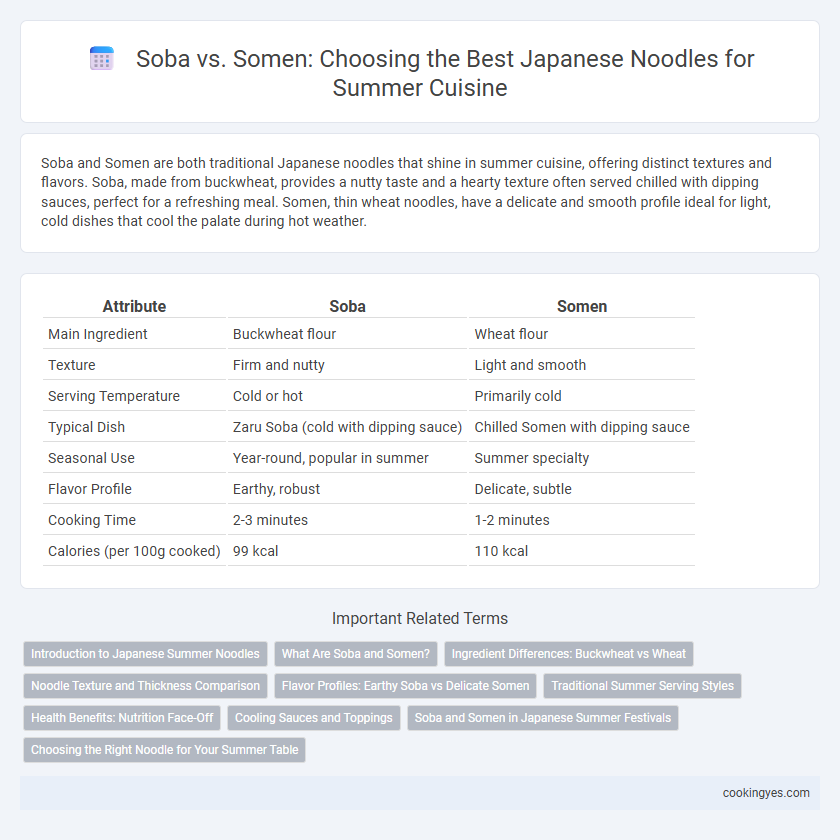Soba and Somen are both traditional Japanese noodles that shine in summer cuisine, offering distinct textures and flavors. Soba, made from buckwheat, provides a nutty taste and a hearty texture often served chilled with dipping sauces, perfect for a refreshing meal. Somen, thin wheat noodles, have a delicate and smooth profile ideal for light, cold dishes that cool the palate during hot weather.
Table of Comparison
| Attribute | Soba | Somen |
|---|---|---|
| Main Ingredient | Buckwheat flour | Wheat flour |
| Texture | Firm and nutty | Light and smooth |
| Serving Temperature | Cold or hot | Primarily cold |
| Typical Dish | Zaru Soba (cold with dipping sauce) | Chilled Somen with dipping sauce |
| Seasonal Use | Year-round, popular in summer | Summer specialty |
| Flavor Profile | Earthy, robust | Delicate, subtle |
| Cooking Time | 2-3 minutes | 1-2 minutes |
| Calories (per 100g cooked) | 99 kcal | 110 kcal |
Introduction to Japanese Summer Noodles
Japanese summer cuisine features refreshing noodles like soba and somen, both prized for their light texture and cooling qualities. Soba, made from buckwheat flour, offers a nutty flavor and is rich in protein and fiber, making it a nutritious choice. Somen, thin wheat noodles often served chilled with dipping sauce, provides a delicate taste and quick cooking time ideal for hot weather.
What Are Soba and Somen?
Soba are thin Japanese noodles made from buckwheat flour, prized for their nutty flavor and firm texture, often served chilled with dipping sauce during summer. Somen are ultra-thin wheat noodles, characterized by their delicate texture and light taste, traditionally enjoyed cold to provide refreshment in hot weather. Both noodles play essential roles in Japanese summer cuisine, offering distinct textures and flavors suited for seasonal dishes.
Ingredient Differences: Buckwheat vs Wheat
Soba noodles are made primarily from buckwheat flour, which gives them a nutty flavor and a slightly darker color, making them rich in protein and dietary fiber. In contrast, Somen noodles consist mainly of wheat flour, resulting in a lighter texture and a delicate, smooth taste ideal for refreshing summer dishes. The different grain bases not only affect flavor and texture but also nutritional content, with buckwheat providing more antioxidants and complex carbohydrates compared to wheat.
Noodle Texture and Thickness Comparison
Soba noodles have a firm, slightly chewy texture with a thickness around 1.5-2 mm, offering a heartier bite suitable for chilled summer dishes. Somen noodles are much thinner, typically less than 1.3 mm, with a smooth, delicate texture that cools quickly and tastes light on the palate. The contrast in thickness and texture between soba's robustness and somen's softness defines their distinct culinary roles in Japanese summer cuisine.
Flavor Profiles: Earthy Soba vs Delicate Somen
Soba noodles offer a rich, earthy flavor derived from buckwheat, providing a nutty taste that complements savory dipping sauces and enhances Japanese summer dishes. In contrast, somen noodles present a delicate, mildly sweet taste with a smooth, silky texture perfect for chilled preparations, offering a light and refreshing palate. The distinct flavor profiles of soba and somen cater to varied preferences, enriching the diversity of traditional Japanese summer cuisine.
Traditional Summer Serving Styles
Soba and somen noodles are iconic choices in Japanese summer cuisine, each featuring distinct traditional serving styles that highlight seasonal flavors. Soba is typically served chilled with a dipping sauce called tsuyu, garnished with chopped green onions, wasabi, and sometimes grated daikon, reflecting a rustic and earthy dining experience. Somen noodles, thinner and more delicate, are often served cold in a bowl of ice water or flowing water (nagashi somen), creating a refreshing and visually dynamic way to enjoy this light, wheat-based dish during the hot summer months.
Health Benefits: Nutrition Face-Off
Soba noodles, made from buckwheat, boast high protein, fiber, and essential minerals like manganese and magnesium, supporting heart health and digestion. In contrast, somen noodles, primarily wheat-based, are lower in protein and fiber but provide quick digestible carbohydrates, making them ideal for light summer meals. Choosing soba over somen can enhance nutritional intake through antioxidants and vitamins, promoting sustained energy and metabolic balance during hot weather.
Cooling Sauces and Toppings
Soba noodles, made from buckwheat, pair well with rich, savory tsuyu sauce infused with dashi, soy sauce, and mirin, complementing toppings like chopped green onions, grated daikon, and wasabi to enhance the cooling effect. Somen, thin wheat noodles, are traditionally served chilled with lighter, subtly flavored chilled dipping sauces that often include ginger and sesame, topped with slivers of nori, thinly sliced cucumber, and shiso leaves for a refreshing summer bite. Both noodles provide distinct textures and flavors that highlight Japan's seasonal emphasis on balance and coolness in summer cuisine.
Soba and Somen in Japanese Summer Festivals
Soba and somen are essential noodles in Japanese summer festivals, each offering unique textures and flavors suited for outdoor celebrations. Soba, made from buckwheat, delivers a nutty taste and a hearty bite, often enjoyed chilled with dipping sauce, providing a refreshing contrast during warmer months. Somen, thin wheat noodles served cold with light dipping sauces, excels in its delicate texture and quick cooking time, making it a popular, easy-to-serve option for festival crowds.
Choosing the Right Noodle for Your Summer Table
Soba noodles, made from buckwheat, offer a nutty flavor and firm texture that pairs well with chilled dipping sauces, making them ideal for a refreshing summer dish. Somen noodles, thin and wheat-based, cook quickly and provide a light, delicate bite perfect for enjoying with cold broths or salads during hot weather. Selecting between soba and somen depends on desired texture and flavor profile, with soba delivering a heartier taste and somen lending a subtle, smooth complement to seasonal ingredients.
Soba vs Somen for Japanese Summer Cuisine Infographic

 cookingyes.com
cookingyes.com